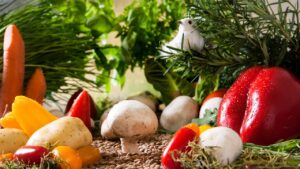Imagine a world where every harvest reaps optimal yields, with bountiful crops that stay fresh and nutritious long after gathering. In the quest for this ideal, post-harvest handling techniques play a vital role in ensuring our precious produce’s quality, safety, and longevity. From reducing losses to preventing spoilage, we delve into the realm of effective post-harvest handling methods that can revolutionize how we store and preserve our agricultural treasures. With a friendly approach, we explore the strategies and innovations transforming the post-harvest landscape, paving the way for a future where every harvest is maximized to its fullest potential.
Importance of Post-Harvest Handling
Post-harvest handling is crucial in preserving and protecting the fruits of our labor. It encompasses a series of practices to minimize post-harvest losses, maintain agricultural produce’s quality and nutritional value, and ensure its safe delivery to the consumer. By implementing effective post-harvest handling techniques, we can reduce the amount of food that goes to waste, maximize the value of our crops, and provide consumers with fresh and nutritious produce.
Minimizing Post-Harvest Losses
One of the primary goals of post-harvest handling is to minimize losses after the crop has been harvested. Various factors, including physical damage, microbial infection, and physiological changes can cause these losses. Proper handling techniques, such as careful harvesting, gentle handling, and prompt cooling, can significantly reduce these losses. Minimizing losses can maximize the quantity of food available for consumption, helping alleviate global food shortages and promote food security.
Preserving Quality and Nutritional Value
Post-harvest handling also plays a critical role in preserving agricultural produce’s quality and nutritional value. Many fruits and vegetables are highly perishable and prone to deterioration due to enzymatic activity, respiration, and moisture loss. By implementing appropriate handling practices, such as proper cleaning, sorting, and packaging, we can slow down the deterioration process and extend the shelf life of our crops. This ensures that consumers receive fresh, flavorful, and nutrient-rich produce, contributing to their health and well-being.
Preparation for Post-Harvest Handling
Proper preparation for post-harvest handling is essential to ensure the success of the storage and preservation process.
Proper Harvesting Techniques
The first step in preparing for post-harvest handling is to employ proper harvesting techniques. Harvesting at the right stage of maturity is crucial for preserving quality and maximizing shelf life. We must carefully monitor crops to determine the optimal time for harvest, considering factors such as color, texture, and aroma. Additionally, using sharp tools and handling crops gently during harvesting helps prevent physical damage and reduce the risk of microbial contamination.
Cleaning and Sorting
After harvesting, cleaning and sorting the produce is vital to remove any dirt, debris, or damaged items. This step helps maintain hygiene and prevents the spread of diseases. Sorting allows us to separate produce based on quality, size, and ripeness, ensuring that the most suitable items move forward in the post-harvest handling process.
Packaging and Transport
Proper packaging and transport are crucial to prevent damage during handling and transit. Packaging materials should protect against physical damage, moisture loss, and contamination. Sturdy crates, boxes, or bags should be used, and cushioning materials should be included to absorb any shocks or vibrations. Proper package labeling is also essential to ensure the traceability and adequate identification of the produce. Additionally, efficient transport logistics, including temperature control and timely delivery, are vital to avoid delays and maintain product quality.
Temperature Management
Temperature management plays a critical role in preserving the quality and extending the shelf life of agricultural produce.
Understanding Optimal Storage Temperatures
Different crops have unique temperature requirements to maintain their quality and freshness. Understanding the optimal storage temperatures for each type of produce is crucial. For example, delicate fruits and vegetables are often stored below freezing to slow ripening and reduce spoilage. On the other hand, some crops, like potatoes, can be stored at higher temperatures to prevent chilling injury. Storing produce at the correct temperature helps to maintain its nutritional content, appearance, and taste.
Cooling Techniques
Rapid cooling of harvested produce is essential to prevent microbial growth and enzymatic activity, which can lead to quality deterioration. Depending on the type of produce and storage facility, different cooling techniques, such as forced-air cooling, hydrocooling, and vacuum cooling, can be used. These methods help quickly reduce the crops’ temperature, allowing them to enter a dormant state and slowing down various metabolic processes.
Cold Storage Equipment
Proper cold storage equipment, such as refrigerators, coolers, and freezing rooms, is crucial for maintaining the desired temperature and humidity levels. These facilities should have appropriate insulation, temperature controls, and ventilation systems to create optimal storage conditions. Regular equipment monitoring is necessary to ensure proper functioning and prevent temperature fluctuations that could harm the product. Investing in high-quality cold storage equipment is essential to maximize product quality and reduce post-harvest losses.
Humidity Control
Humidity control is another crucial aspect of post-harvest handling, as it directly affects agricultural produce’s quality and shelf life.
Effects of Humidity on Stored Produce
Humidity levels can significantly impact the moisture content of crops, leading to mold growth, wilting, and texture changes. High humidity levels can cause excessive moisture loss, drying out the produce, while low humidity levels can lead to excessive moisture uptake and promote microbial growth. Finding the right balance of humidity is vital to maintaining the freshness, appearance, and nutritional value of the produce throughout the storage period.
Humidity Monitoring and Control
Regularly monitoring and controlling humidity levels are essential to ensure the storage environment remains within the desired range. This can be achieved using hygrometers and humidity sensors. If the humidity levels are too high, proper ventilation can help remove excess moisture. Conversely, if the humidity levels are too low, misting or using humidifiers may be necessary to add moisture to the storage environment. Achieving and maintaining the optimal humidity levels for different crops will help extend their shelf life and preserve their quality.
Ventilation and Air Circulation
Proper ventilation and air circulation are crucial in creating the ideal storage conditions for agricultural produce. Adequate ventilation helps remove excess heat, carbon dioxide, and ethylene gas, which can contribute to the deterioration of stored crops. It also promotes fresh air exchange, providing the produce with the necessary oxygen for respiration. Ensuring proper airflow within the storage facility helps maintain consistent temperature and humidity throughout, minimizing the risk of localized hotspots or condensation.
Ethylene Management
Ethylene is a naturally occurring plant hormone that plays a significant role in ripening. Managing ethylene levels is crucial, as some crops are susceptible to its effects.
Understanding Ethylene Production
Ethylene is produced by crops, particularly during the ripening stage, and can accelerate the deterioration of nearby produce. Fruits, such as apples, bananas, and tomatoes, produce and release higher amounts of ethylene. Proper handling and storage techniques are necessary to prevent the accumulation of ethylene, which can lead to premature ripening and spoilage.
Ethylene-sensitive Produce
Certain crops, like lettuce, cucumbers, and broccoli, are highly susceptible to ethylene and can rapidly deteriorate when exposed to even small amounts of the hormone. Therefore, storing ethylene-sensitive produce away from ethylene-producing crops is essential to prevent premature spoilage and maintain their quality. Separation by physical barriers or storage in separate areas can help minimize the risk of ethylene exposure.
Ethylene-absorbing Materials
Using ethylene-absorbing materials, such as activated carbon filters or sachets, can help reduce the levels of ethylene in the storage environment. These materials absorb ethylene gas, preventing it from affecting nearby produce. Incorporating ethylene-absorbing materials into the storage facility or packaging can help extend the shelf life of ethylene-sensitive crops and maintain their quality for a more extended period.
Pest and Disease Control
Effective pest and disease control measures are essential to prevent post-harvest losses and ensure the safety and quality of stored crops.
Cleaning and Sanitizing
Proper cleaning and sanitizing of storage facilities and equipment are crucial to prevent the buildup of pests and diseases. Regular cleaning removes dirt, debris, or residual organic matter that could attract pests or harbor pathogens. Appropriate sanitizing agents can help eliminate bacteria, fungi, and other microorganisms, minimizing the risk of contamination and spoilage. Maintaining a clean and hygienic environment is vital for preserving the quality and safety of stored crops.
Integrated Pest Management
Implementing an integrated pest management (IPM) approach is essential for sustainable and effective pest control. IPM combines various strategies, including cultural practices, biological control methods, and the judicious use of pesticides. Monitoring and early detection of pests, employing physical barriers, implementing biological controls (such as introducing beneficial insects or using pheromone traps), and targeted pesticide applications can help prevent infestations and minimize the need for conventional chemical treatments.
Use of Chemical Treatments
While chemical treatments should be used judiciously and as a last resort, they can be essential for controlling specific pests and diseases. When using pesticides, following the recommended dosage, application methods, and safety precautions is crucial. Careful consideration should be given to selecting pesticides approved for use on specific crops that have minimal environmental and human health impact. Proper handling, storage, and disposal of pesticides are necessary to minimize risks and prevent contamination.
Handling of Specific Crops
Different crops have specific handling requirements to maintain quality and maximize shelf life.
Fruits and Vegetables
Fruits and vegetables are highly perishable and require careful handling to maintain their quality. Delicate fruits, such as berries, cherries, and peaches, should be handled gently to prevent bruising. Leafy greens and vegetables benefit from immediate cooling to maintain crispness and avoid wilting. Some produce, like apples and oranges, can be stored for extended periods with proper temperature and humidity control. Understanding different fruits and vegetables’ unique characteristics and requirements is vital for their successful post-harvest handling.
Grains and Pulses
Grains and pulses, such as rice, wheat, lentils, and beans, require proper processing, cleaning, and storage to maintain quality and prevent pest infestations. These crops should be dried to appropriate moisture levels to prevent mold growth and insect activity. Proper packaging, such as airtight containers or grain bags, can help protect these crops from moisture, pests, and physical damage.
Root Crops and Tubers
Root crops, including potatoes, carrots, beets, and tubers like yams and sweet potatoes, require careful handling and storage to prolong their shelf life. These crops should be cured, cleaned, and stored in relaxed, dark environments to prevent excessive sprouting, rotting, or wilting. Ensuring proper ventilation and humidity control is crucial to maintaining their quality and avoiding the accumulation of ethylene gas, which can accelerate spoilage.
Optimal Storage Conditions
Understanding and providing optimal crop storage conditions is essential to preserve their quality and extend their shelf life.
Length of Storage
Different crops have varying storage capabilities, with some able to be stored for longer periods than others. Understanding the expected shelf life of each crop is crucial in determining the appropriate storage conditions and rotation schedules. Regular inspection and sampling help identify any signs of spoilage or quality deterioration, ensuring that only the best produce is available to consumers.
Suitable Containers and Packaging Materials
The choice of containers and packaging materials directly impacts stored crops’ quality and shelf life. Containers should be sturdy, pest-resistant, and have adequate ventilation to prevent the buildup of carbon dioxide. Packaging materials should protect against physical damage, moisture loss, and microbial contamination. Porous materials, like perforated plastic bags or breathable films, can help control moisture levels and extend the shelf life of certain crops.
Storage Facility Design
The design of the storage facility should consider factors such as insulation, air circulation, and temperature and humidity control. Proper insulation helps maintain a consistent internal environment and minimize temperature fluctuations. Adequate air circulation promotes consistent temperature and humidity throughout the storage area. Consideration should also be given to the layout and organization of the storage facility to facilitate easy access, inspection, and rotation of stored crops.
Monitoring and Quality Control
Regular monitoring and quality control measures are vital to ensure the freshness and safety of stored crops.
Regular Inspection and Sampling
Regular inspection of stored crops helps identify any signs of spoilage, disease, or pest infestation. Visual inspection, sensory evaluation, and sampling for laboratory analysis provide essential information on the quality, shelf life, and safety of the produce. Early detection of any issues allows for prompt action, preventing the spread of disease or the loss of entire storage batches. Maintaining accurate inspection results and sample records is also essential for traceability and quality assurance.
Controlled Atmosphere Storage
Controlled atmosphere storage (CAS) involves manipulating the storage environment by adjusting oxygen, carbon dioxide, and ethylene levels. This technique can help extend the shelf life of certain crops by inhibiting microbial growth, slowing down ripening, and reducing physiological changes. By creating an optimal atmosphere for specific crops, CAS allows for more extended storage periods while maintaining product quality.
Quality Assurance Programs
Implementing quality assurance programs, such as Good Agricultural Practices (GAP) or Hazard Analysis and Critical Control Points (HACCP), helps ensure that all post-harvest handling practices meet the highest standards. These programs provide guidelines and protocols for handling, storage, transportation, and quality control. By following these programs, we can minimize the risk of contamination, maintain product quality, and protect consumer health and safety.
Education and Training
Education and training are essential to equip individuals involved in post-harvest handling with the knowledge and skills needed to implement effective practices.
Awareness of Best Practices
Awareness of best practices in post-harvest handling is crucial to ensure proper techniques are followed at every process step. This includes educating farmers, harvesters, storage facility operators, and transportation personnel on the importance of quality preservation and safety. Proper handling techniques, hygiene practices, and appropriate equipment and materials should be emphasized to minimize losses and maximize product quality.
Skill Development for Workers
Training and skill development opportunities for workers involved in post-harvest handling are essential for optimal storage and preservation outcomes. Training programs can cover proper harvesting techniques, cleaning and sorting procedures, temperature and humidity control, and pest management practices. By improving workers’ skills and knowledge, we can enhance the effectiveness of post-harvest handling practices and minimize losses due to mishandling or improper storage conditions.
Continuing Education Opportunities
Continuing education opportunities, such as workshops, seminars, and online resources, keep individuals updated on post-harvest handling advancements and best practices. These opportunities allow workers to stay informed about new technologies, research findings, and industry trends. Continuous learning and professional development enable individuals to adapt and implement innovative techniques to further enhance the quality and efficiency of post-harvest handling processes.



